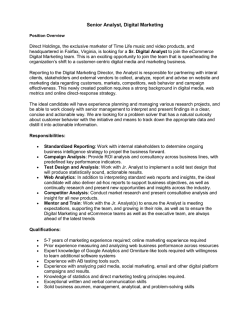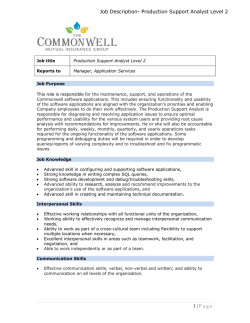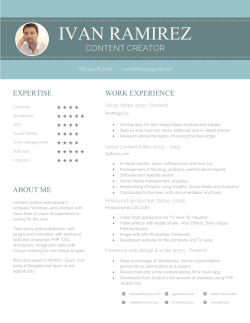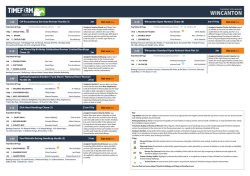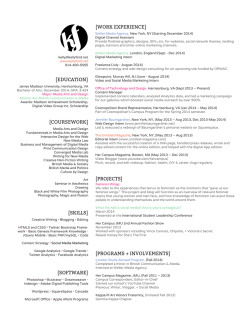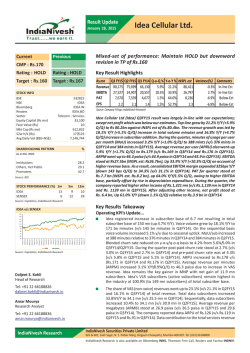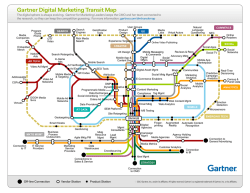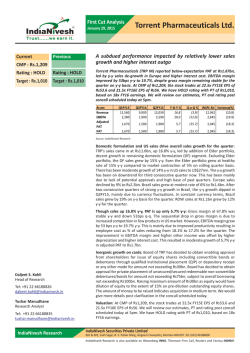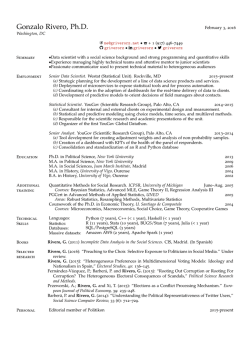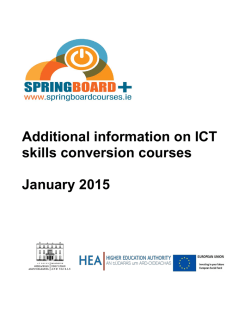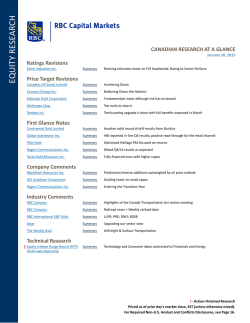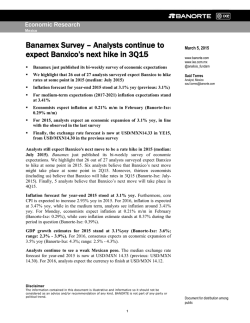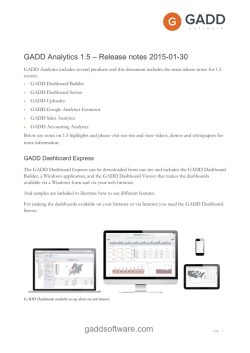
Big Data Talent: Data Scientist versus Business Analyst versus
INFORMATION TECHNOLOGY AND A NALYTICS • SUBHASHISH SAMADDAR, FEATURE EDITOR, Georgia State University Big Data Talent: Data Scientist versus Business Analyst versus Business User by Coleen Wilder and Ceyhun Ozgur, Valparaiso University he first sentence in one of the books on the top shelf of our bookcase reads: "We are drowned in oceans of data; nevertheless, it seems as if we seldom have sufficient infonna tion (Goldratt, 1990, p. 3)." Inte resting that this was written in 1990 in a book entitled The Haystack Syndrome and subtitled Sifting Tnformation Ollt of the Data Ocean. Clearly the title was meant to conjure images of sifting through a haystack to find the proverbial needle. Move down a few shelves and YOll will find the third edition of the book, Data Mining Techniques. Several pages into the text it reads, "This book is about analyti cal techniques that can be used to turn customer data into customer knowledge (Berry & Linoff, 2011, p. 2) ."1 A solution to Goldratt's commdrum was underway. The analogy, however, was changed from a needle in a ha ystack to that of mining, which entails sorting through less valu able rock and sand to find more valuable nuggets of gold . The bottom shelf of our bookca se is where we store our favorite journals. At the top of this stack is the October 2012 edition of the Harvard Business Revie·w; the cover has a caricature of a lion tamer with a whip in his hands attempting to tame "Big Data." Flip through the pages and you will see the following passage high lighted: "Advanced analytics is likely to become a decisive competitive asset in many industries ilnd a core element in companies' efforts to improve perfor mance" (Barton & Court, 2012, p. 89). Are we prepared for this challenge? As college professors, are we equipping our students with the skills and knowledge they will need to sllcceed? According to the McKinsey Global lnstihlte, "There will be a shortage of talent necessary for T Coleen Wilder is an assistant professor of lIIaliagement ill tlte College of Bllsiness at Valparniso Ulli versity. She eamed a ill lIIathematics from Illdialla Un iver5ity and an MBA fro III the Ulliver5ity of Chicago . She aimed Iler PhD ill management science from IItinois In;;titllte of Teclwology. as co!.! ,, n .wi I d erlYv.l lpo.cdll Ceyhun Ozgur is a professor of information and decision sciences in the Cvllege vf allsiness at Val paraiso University. Hceam ed a PliO iI/ bllsiness (operation Mal/ugemell t/Operatiolls Rese"rch ! fro m Kellt State University, UII MS in mal/agel/lent, and a as in indllstrial management from th" University vf Akrllll . He p/lblish ed Introduction to Manage ment Science with Spreadsheets, 1st edition (witli Willialll f. StCVCl1s0n, McGrnw-Hill!. He has also published articles in Operations Manage ment Research, Decision Sciences Joumal of Innovative Education, Interfaces, Quality M~nagement Journ a I, Production Planning & Control, and OMEGA. ceyhun.ozgur@" .lpo. cd L1 DECISION LINE 20 organizations to take advantage of big data " (Manyika et ai, 2011, p. 10). The next question is, therefore, what type of talent is needed? And, as educators, how do we deve lop this talent? The best way to describe the type of talent needed to tackle big da ta is to look at the different levels of expertise that ex ist today. Although different professional ti tIes ma y be used , three d ifferen t levels are commonly observed. A description of each follows: • Data scientist. McKinsey refers to these individ uals as possessing "deep " analytical skills. They must have "a solid foundation in math , statistics, probability, and computer science and programming" with the ability to write code at the forefront (Davenport & Patit 2013, p. 74). • Business analyst. McKinsey refers to these individuals as "data savvy managers. " They "simply need enough conceptual knowledge of statistics and quantitative skills to be able to frame and interpret business statistical analy sis in an effective way (Manyika et aI., 2011 , p. 105)." • Business user. McKinsey re fers to these individuals as "supporting tech nolog y personneJ," but Watson (2013) offers a more concrete definition of this group. They need to understand how to store, access, and analyze data. The following example is used to demon strate the contribution made by each of the professions in resolving a problem. A major steel manufacturer was building a new chemical laboratory and needed to decide how many lab testing machines were needed to minimize delays. The machines were multi-million dollar maOCTOS E/< 20 13 chines, and it would be frowned upon should they be too idle, Likewise, it would be frowned upon should they be too busy, thereby delaying steelmaking operations pending lab results, A "busi ness user" gathered historical data from the data warehouse on processing times, volume, and other critical information to generate a report for the lead chemist, a "business analyst," The lead chem ist Llsed Excel to run simple "what-if" analyses, but nothing conclusive was determined, Knowing how important the project was to the company and the limited knowledge he had of analyti cal techniques, the lead chemist turned things over to a data scientist for a thor ough examination, After developing a gueuing model using SAS, the data scien tist gave the results back to the business analyst to make the final decision on the optimal number of machines for the new lab, The business user played a key role in helping the business analyst visualize the situation, The business analyst was held accountable for the results and due to the importance of his decision called upon the expertise of a da ta scien tist. Each professional had different respon sibili ties and used different tools to fulfill their responsibilities, As advanced analytics become the " decisive competitive asset" it is predicted to become, it will raise the bar for analytical skills reguired of the workforce, In the past, it was accept able to relinguish all statistical work to a statistician--not in the future, £n order for analytics to become a "core element" in companies, it is important that all levels in the organization have a working knowledge of analytics , Data scientists will continue to do the complex, strate gic problems but simpler efforts will be the domain of a business analyst, This transition has been going on since Excel made it easy to do a regression analysis, A good business analyst knows when to consult a data scientist and when to use their own expertise, Their primary contribution is to interpret the results and to recognize opportunities that require analytical study. The role of a business user should not be undermined in this process, In fact, more attention needs to DECISION LINE be given to the quality of data used in the model building process an area well suited to a business user, £n order to develop the different levels of expertise, many curriculums will need to be revised , It is imperative that courses for data scientists, business analysts, and business users are tailored to meet their individual needs, Administrators will be tempted to lower costs by teaching gen eral concepts to reach a larger audience, but research has shown this method to be ineffective, "Mathematically-trained teachers often imagine that they can gain efficiency by presenting general principles or structures first, followed by concrete 'specia I cases.' This doesn't work, Few people learn from basic principles down to special cases, Seeking efficiency in this way was the primary failing of the New Math movement of a generation ago " (Moore, 2001, p, 9), Many schools are implementing programs at the graduate level as mul tidisciplinary programs; Northwestern, New York, North Carolina State, and the University of Arkansas are just a few examples of universities with such programs, (Website addresses for the above mentioned universities are given in the endnotes ,) Companies will not be able to fully leverage their data, how ever, without increasing the number of data savvy employees at all levels of the organization, This necessity requires un dergraduate exposure as well. The good news is that universities are responding to market demand with undergraduate majors, minors, and certificates, but most appear to target the role of data scientist. The University of Arkansas has a great program in place that includes certifi cates and access to real-world data , The skill sets and knowledge of a business analyst may be separated into the following four domains: Functional knowledge, data management, models and techniques, and communication, Functional knowledge is listed first in order to emphasize its importance, A student planning to work as a business analyst in marketing would need to complete the required courses to obtain a minor in marketing, at a minimum, Business analysts need to have skills that 21 will allow them to extract, transform, and load (ETL) data, merge and match different data sources, handle missing data, and cleanse data, Their knowledge of models and techniques should include basic operCltions along with the strengths and weakness of various models, They should be able to construct simp Ie mod els but realize the complexities involved which reguire the expertise of Cl data scientist, The breadth of study should include models from the descriptive, predictive, and prescriptive areas of analytics, Finally, the communication component of their education should include problem definition and framing, interpretation of the results, and practice in communicating complex ideas to gen eral audiences in both written and oral formats, Real-world data needs to be available to fully understand the complexities and value of the models, For example, cus tomer segmentation is a common objec tive for many companies, Most customer segmentations can be done with neural networks, discriminan t ana lysis, logistic regression and cluster analysis, Class examples should compare and contrast the methods and their respective results, Although we recommend that course work for each profession is tailored and separate, the curriculum should include a senior team project that brings all the professions together, thereby replicating a real-world experience, Teams of three or four could be constructed yvith at least one business user, business analyst, and a data scientist. The largest bookcase in our office sits in the middle of our desk, In stature, it pales in comparison to the shelves that flank our office, On our screen is it headline that reads "The Age of Big DClta-BBC Documentary " (KDNuggets, 2013), We both have a bag of popcorn in hand as we prepare to watch the 58-minute documentary that includes a story about how the Los Angeles Police Department (LAPD) receives a forecast on where crime is most likely to occur in the next 12 hours, see BIG DATA. page 42 OCTOBEr~ 2013 from BIG DATA, pag e 21 Endnotes 1. It should be noted that the first edi tion of Berry and Linoff's book was released in 1997. 2. Websites for universities mentioned in article: Northwestern University: ww w.alla lylics.noJ.th w esteJ.l1.edu/ New York University: www.stern .ny u .cdu.lprogl.afils North CarolinCl State University: anal ytic5,ncs ll.ed.u University of Arkansas: wal toncol lege. uark.edu.lisysl Davenport, T. H., & Patil, D. (2013). Data scientist: The sexiest job of the 21st centu ry. Hllrvard Business Review, 90(10),70-76. Goldratt, E. M. (1990). The haystllck syn drome. Croton-on-Hudson : North River Press. KDNuggets . (2013, August). Publica tions. Retrieved August 12, 2013, from KDNuggets web site: www.kd nuggets. com/2013/08/b b c-documen ta ry-age-of big-d :lta .html Manyika, J., Chui, M., Brown, B., Bughin, J., Dobbs, R , Roxburgh, c., et al. (2011). Big data: The next frontier faT innova tion , competition, and productivity. McKinsey Global Institute. Submitting articles to Decision Line Members are invited to submit essays of about 2,000 to 2,500 words in length on topics of their interest, especially articles of concern to a broad, global audience. Please send essays (including brief bio and photo) to either the respective feature edi tor or to Editor Maling Ebrahimpour. Deans' Perspective & Editor Milling Ebrahimpour, University of South Florida, Saint Petersburg [email protected] Doctoral Stlldent Afjilirs Vamn Grover, Clemson University vgrover®cIemson.edu References Barton, D., & Court, D. (2012). Mak ing advanced Clnalytics work for you. Harvard Business Review, 90(10), 79-83. Berry, M.J., & Linoff, G S. (2011). Dlltll min ing techniques (3 ed.). Indianapolis: Wiley. Moore, D. S. (2001) . Undergrad ua te pro grams and the future of academic statis tics. The American Stlltisticilln , 55(1),1-6. Watson, H. J (2013, May IJune). The business case for analytics. BizEd, XIl(3), 49-54. • E-Con/mercc Kenneth Kendall, Rutgers, The State University of New Jersey [email protected] FrOIl/ the Bookshelf Jilmes Flynn, lndianil University, fndpls. ejflynn@iupuiedu In tire Classroom Kilthr)'n Zuckweiler, University of Nebraska, Kearney [email protected] The 2013 OS. Annual Meeting will be held at the Baltimore Marriott Waterfront Hotel, 700 Aliceanna Street, BaHi more, MO 21202. This Inner Harbor hotel sits on the water's edge, offers spectacular views and is conveniently located in the nea r Harbor East neighborhood. The hotel prOliides easy access to the city's finest shops, restau rants and is in dose proximity to the National Aquarium, Maryland Science Center, and the convention center, among many other visitor destination points in this historic ci ty. The closest airport, Baltimore/Washington International Thurgood Marshall Airport-BWI, is only 12 miles away. DEC1~rON LfNE 42 IlIj,,,,,,,"liOIl Technology and Allail/lies Subhashish Samilddar, Georgia State University [email protected] 1l1femationllllsslles Andre Everett, Universi ty of 01<1 go, New Zealand [email protected] Melll/J~rship Roundtable Gyula Vastdg, University of Pannonia/ CorvinllS University of Budapest [email protected] Production/Operatiolls Mmra:;renrent Daniel 11.. Samson, University of Melbourne, Australia [email protected] Research [ ", rlC.; Mahyar Amouzegur, Cillifornia State Polytechnic UniverSity, Pomona [email protected] OCTOBGR 2013
© Copyright 2026
